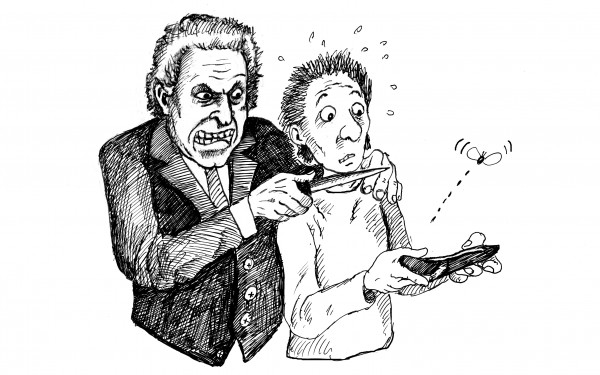My Way and the Highway (Code)
Every so often, I need to clear the seemingly interminable clutter that piles up in the form of books and documents on my desk.
Why? While covering a protest on July 24, I was detained by an SPVM officer and given a ticket for committing journalism in the first degree. While this “crime” isn’t strictly on the “books,” or prohibited in any “law” that could be described in “quotation marks,” my offense was instead codified through article 500.1 of the Highway Safety Code of Quebec.
This article makes it an offence to occupy “a public road in the course of a concerted action meant to block the circulation of vehicles.”
The last time my words graced these opinions pages, I methodically broke down the reasons why I would contest the $500 ticket, and how ludicrous it was for a police officer to use 500.1 against a journalist whose only “concerted action” was to report on events as they unfolded.
Well, after months of waiting for my day in court, I finally got some news on the matter last Thursday. Thing is, it didn’t come from city hall or Montreal police. Instead, it came from the Superior Court of Québec, which just struck down using article 500.1 to break up protests, on the basis of its unconstitutionality.
Yes, just as I had argued that 500.1 shouldn’t be applied to journalists during protests, Justice Guy Cournoyer ruled that it shouldn’t apply to, well, anyone at all.
The ruling stems from an anti-police brutality march in 2011, in which several protesters were kettled and ticketed under the infamous article of the Highway Code. One of the protesters to contest this was Gabriella Garbeau, whose case eventually made its way to municipal court.
The argument made was that article 500.1 encroached on Garbeau’s right to freedom of expression and assembly, as guaranteed by the Canadian Charter of Rights and Freedoms.
In his ruling on that municipal case, Judge Richard Starck found that the article was indeed an infringement, but one that was reasonable in a free and democratic society. Garbeau appealed the ruling and took the case to Superior Court, where Justice Cournoyer was all like, “Nah son. That ain’t right, son.”
Specifically, he countered Judge Starck’s conclusion that the application of 500.1 by police was a reasonable limit on a constitutionally guaranteed freedom. The question of whether a limit is justifiable derives from the Oakes Test, a framework established by the Supreme Court of Canada in the case of R v. Oakes back in 1986.
The test considers if there’s a pressing need for any law that might curb rights, and whether there’s a sufficient proportionality between what is gained through the law, and what is lost in terms of freedoms.
Thursday’s Superior Court ruling indicates that article 500.1 failed the Oakes test.
“[Article 500.1’s] limitation is not justified in a free and democratic society,” Justice Cournoyer wrote, and with that, he ordered that article 500.1 be invalidated.
For Gabriella Garbeau, the appellant in this case, Thursday’s ruling was encouraging, but only served to confirm something she already firmly believed.
“I have the right to protest, and the streets belong to us. I already had the answer before the judge said it.” -Gabriella Garbeau
“I wasn’t necessarily waiting for this judgment in order to protest on the street,” Garbeau said. “I have the right to protest, and the streets belong to us. I already had the answer before the judge said it.”
While some might feel that Garbeau’s sentiment is overconfident, Quebec Superior Court and municipal judges often strike down laws, articles and provisions that encroach on our right to express ourselves and freely assemble, reaffirming our guaranteed Charter rights.
So if the courts routinely find these laws to be unconstitutional, why are similar ones—like the contentious P-6 bylaw—still being enforced by scores of riot police officers at almost every protest?
Who better to ask than the symbol of the 2012 protest movement, Anarchopanda?
“The goal is to intimidate, to make people scared to protest,” Anarchopanda told me in a phone interview. “The goal is also to continue to instill this vague climate of fear that makes people think that they need the police to be there. It’s a self-serving system for the police.”
It’s hard not to share his perspective.
Just last month, I covered a protest attended by about 50 students. As they left Phillips Square, they were cut off by an equal number of cops in full riot gear, for trying to march on the sidewalk. As impartial as one tries to be in these situations, every journalist I saw had their brow firmly furrowed, and we communally shared expressions that read, “is this really happening?”
Anarchopanda points to a similar protest last spring, which saw 100 or so high schoolers march in opposition to austerity. They too were treated to a full riot-cop escort.
“In any sane society, people would wonder ‘what the fuck is going on?’ Do the police seriously think they need to muster riot police to handle a protest of 100 high school kids?” Anarchopanda said. “But they’ve succeeded in making this the new norm.”
Despite the attempts to suppress demonstrations in Montreal, the activists keep on marching—and I’ll keep on covering their protests. While it’s true that those who have already paid their 500.1 tickets won’t be getting a refund, the Superior Court’s decision is still a positive development. I know that my wallet and I will be celebrating.
At the end of the day, Garbeau believes there are still many obstacles in the way of free speech in Montreal, but the 500.1 victory is still an important one nonetheless.
“After this, maybe people will be more inclined to believe they have a right to protest,” she said.
If nothing else, the courts seem to agree with her.

_600_832_s.png)




